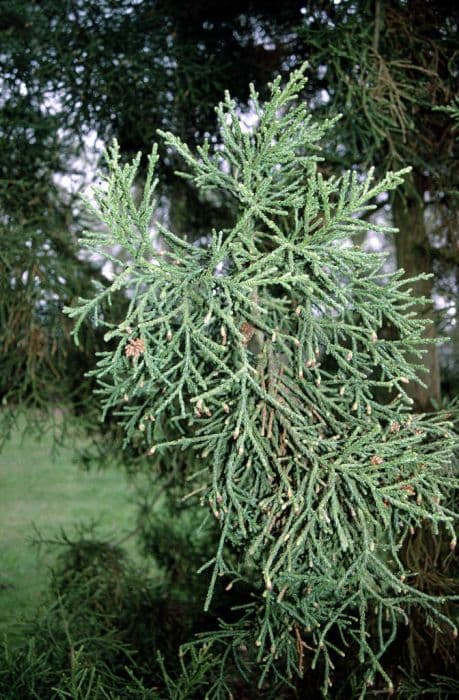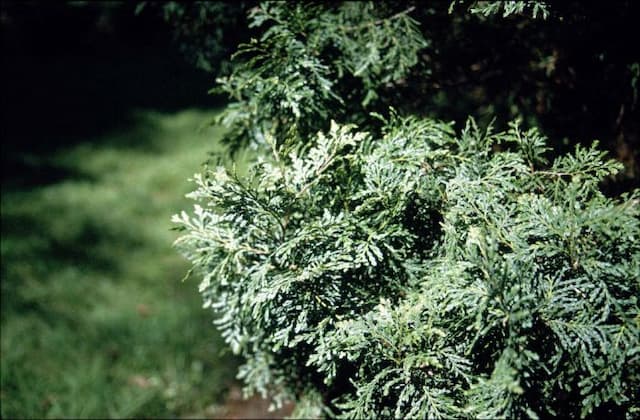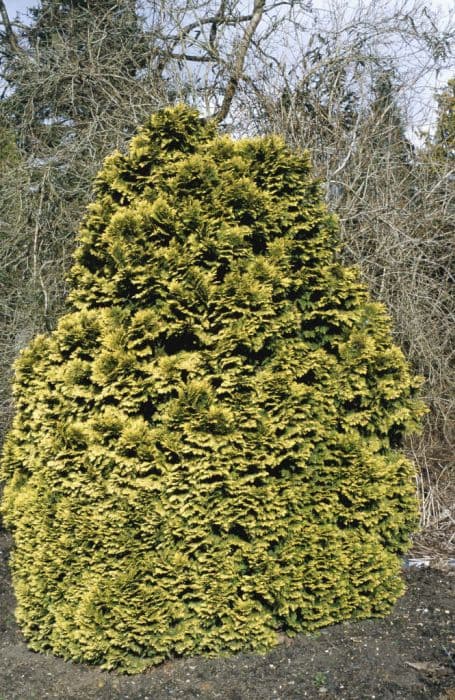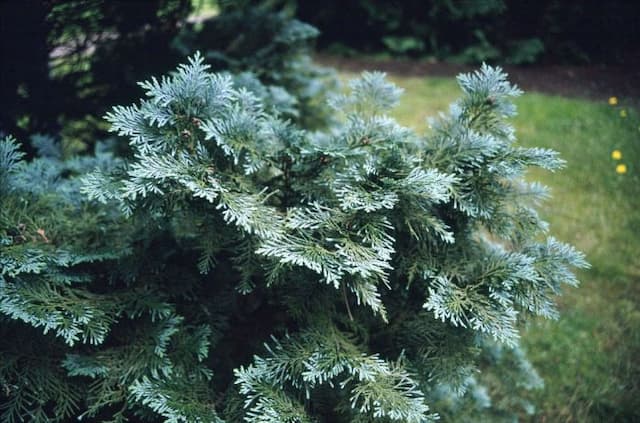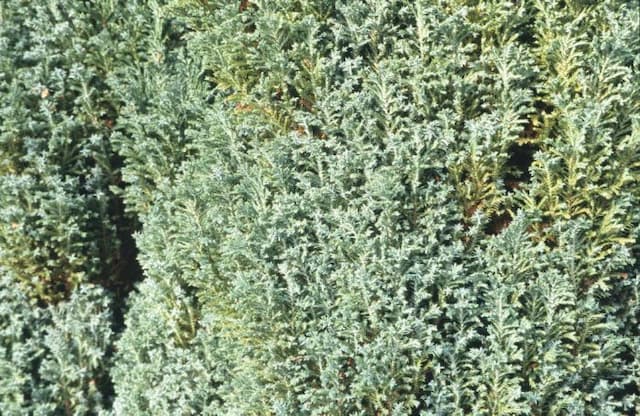Russian Cypress Microbiota decussata

ABOUT
The plant known as Siberian cypress is a low-lying, evergreen shrub with a spreading habit. Its feathery foliage is comprised of soft, scale-like needles, which provide an attractive, dense green mat-like cover over the ground. The color of the needles can vary with the seasons; they are generally a rich green during the warmer months and can take on a bronze to purple hue in colder weather. The texture is lush and fine, giving it a delicate appearance despite its hardy nature. The Siberian cypress produces small, inconspicuous cones, but it is primarily grown for its foliage rather than its floral or fruiting characteristics. This plant is often used in landscaping for ground cover due to its aesthetic appeal and low maintenance needs.
About this plant
 Names
NamesFamily
Cupressaceae
Synonyms
Russian Cypress, Siberian Cypress, Russian Arborvitae
Common names
Microbiota decussata
 Toxicity
ToxicityTo humans
The plant commonly known as Russian Cypress (Microbiota decussata) is not known to be toxic to humans. There are no commonly reported symptoms of poisoning since it is not considered a poisonous plant. Therefore, ingesting parts of the Russian Cypress is unlikely to lead to significant toxic consequences.
To pets
The plant commonly known as Russian Cypress (Microbiota decussata) is also not known to be toxic to pets. It does not contain known toxins that would cause symptoms of poisoning in animals if ingested. As with humans, pets are unlikely to suffer significant toxic consequences from ingesting parts of the Russian Cypress.
 Characteristics
CharacteristicsLife cycle
Perennials
Foliage type
Evergreen
Color of leaves
Green
Height
1-2 feet (0.3-0.6 meters)
Spread
6-8 feet (1.8-2.4 meters)
Plant type
Shrub
Hardiness zones
3
Native area
Siberia
Benefits
 General Benefits
General Benefits- Drought Tolerance: Microbiota decussata, commonly known as Siberian cypress, has the ability to withstand periods of low moisture, making it suitable for xeriscaping or gardens with limited water availability.
- Low Maintenance: Siberian cypress requires minimal pruning and upkeep once established, making it an excellent choice for gardeners seeking low-maintenance landscaping options.
- Cold Hardiness: It is extremely cold-tolerant, capable of surviving in harsh winter conditions down to USDA plant hardiness zone 2.
- Erosion Control: The dense mat-like growth habit of Siberian cypress helps prevent soil erosion on slopes and banks.
- Ground Cover: Its spreading nature covers the ground effectively, suppressing weeds and reducing the need for mulching.
- Aesthetic Appeal: With its feathery, soft green foliage that turns to a bronze-purple hue in winter, Siberian cypress adds seasonal interest to the landscape.
- Wildlife Habitat: Provides cover for small wildlife and insects, creating a more diverse and sustainable garden ecosystem.
 Medical Properties
Medical PropertiesThis plant is not used for medical purposes.
 Air-purifying Qualities
Air-purifying QualitiesThis plant is not specifically known for air purifying qualities.
 Other Uses
Other Uses- Ground Cover: Siberian Cypress can be planted on slopes for stabilizing soil and preventing erosion due to its dense foliage.
- Winter Garden Interest: In colder climates, Siberian Cypress provides a touch of green throughout the winter, as it turns a bronze-purple color in response to the cold.
- Bonsai: Due to its slow growth habit and attractive foliage, Siberian Cypress is suitable for training into a bonsai.
- Aromatic Foliage: When the leaves are crushed, they emit a pleasant aroma, thus it can be used along walkways where people may brush against the foliage.
- Habitat Creation: By providing cover, Siberian Cypress helps in creating habitats for small animals, particularly insects and birds.
- Windbreak: When planted in rows, it can act as a windbreak for smaller plants, protecting them from strong winds.
- Urban Landscaping: Because of its resistance to pollution and compact size, Siberian Cypress is suitable for urban spaces like street medians and public gardens.
- Landscape Contrast: The fine texture and low height of the Siberian Cypress provide excellent contrast when planted with larger-leaved or taller shrubs and perennials.
- Thematic Gardens: It can be used in Japanese style or rock gardens due to its natural form and complementary aesthetic with such design elements.
- Seaside Planting: Its tolerance to salt makes it a suitable option for gardens near the ocean where salt spray can be an issue for other plants.
Interesting Facts
 Feng Shui
Feng ShuiThe Siberian Carpet Cypress is not used in Feng Shui practice.
 Zodiac Sign Compitability
Zodiac Sign CompitabilityThe Siberian Carpet Cypress is not used in astrology practice.
 Plant Symbolism
Plant Symbolism- Resilience: Microbiota decussata, commonly known as Russian arborvitae, can survive harsh conditions and poor soils, symbolizing the ability to thrive against the odds.
- Adaptability: The Russian arborvitae's capacity to adapt to various environments represents flexibility and the willingness to adjust to changing circumstances.
- Low Maintenance: This plant's reputation for being low maintenance can symbolize self-sufficiency and independence in personal growth or relationships.
- Gentle Strength: Russian arborvitae may not be the tallest or the most striking plant, symbolizing a quiet, understated kind of strength that doesn't need to boast.
 Water
WaterSiberian Cypress prefers consistent moisture, especially during the first growing season to establish a deep, extensive root system. After establishment, they can tolerate drier conditions and should be watered deeply, but infrequently. Generally, water the plant with about 1 gallon per week, depending on the climate and soil drainage. During periods of drought or extreme heat, increase watering to twice per week, ensuring the soil doesn't become soggy. Overwatering can lead to root rot, so allow the soil to dry out partially between waterings.
 Light
LightSiberian Cypress performs best in full sun to partial shade. It should be planted in a spot where it receives at least 4 to 6 hours of sunlight per day, but can also benefit from some afternoon shade in hotter climates. The ideal location would offer morning sunlight and protection from the intense late-day sun, especially in Southern regions.
 Temperature
TemperatureSiberian Cypress is hardy and can tolerate a wide temperature range, surviving extremes from about -50 to 90 degrees Fahrenheit. However, its ideal temperature range for optimal growth is between 60 and 70 degrees Fahrenheit. Avoid locations where winter temperatures frequently drop below -50 degrees Fahrenheit as prolonged exposure to such cold may damage the plant.
 Pruning
PruningPrune Siberian Cypress to maintain its shape and remove any dead or damaged branches, which helps to encourage healthy growth and improves airflow. The best time for pruning is late winter or early spring before new growth starts. Pruning is typically done once a year, but can be performed as needed to remove any problematic branches.
 Cleaning
CleaningAs needed
 Soil
SoilRussian Cypress thrives in well-drained soil with high organic content. A mix of garden soil, peat moss, and sand in equal parts creates an ideal environment. The soil pH should be slightly acidic to neutral, ranging from 5.5 to 7.0 for optimal growth.
 Repotting
RepottingRussian Cypress, being a slow-growing shrub, does not require frequent repotting. It can be repotted every 3 to 5 years or when it has outgrown its current container or the soil has degraded.
 Humidity & Misting
Humidity & MistingRussian Cypress does well in average humidity levels typical of outdoor environments. It does not have specific humidity requirements and can tolerate the humidity levels found in most temperate climates.
 Suitable locations
Suitable locationsIndoor
Grow Russian Cypress in bright indirect light, with cool temperatures.
Outdoor
Plant Russian Cypress in partial shade; ensure soil drains well.
Hardiness zone
3-7 USDA
 Life cycle
Life cycleSiberian Cypress (Microbiota decussata) begins its life as a seed, which germinates in spring if conditions are suitable – typically requiring a period of cold stratification to break dormancy. Upon germination, the seedling develops a primary root system and a shoot that grows into a prostrate, ground-covering shrub. As the plant matures, it forms scale-like leaves and slender, horizontal branches that give it a feathery appearance. The Siberian Cypress is dioecious, with male and female reproductive structures on separate plants; pollination occurs primarily through wind-dispersal of the male pollen to the female cones. After successful fertilization, female cones mature, turning brown and releasing seeds the following autumn, ready to restart the cycle. Throughout its life, which can span several decades, the plant continues to spread horizontally, forming a dense, carpet-like mat.
 Propogation
PropogationPropogation time
Spring-summer
Microbiota decussata, commonly known as Russian Cypress or Siberian Cypress, is typically propagated by semi-hardwood cuttings. The best time for taking cuttings is during late summer to early autumn. To propagate, one cuts a length of semi-hardwood stem 4 to 6 inches (about 10 to 15 centimeters) long from a healthy parent plant, ensuring that a few sets of leaves are present. The lower leaves are removed and the cut end is dipped in rooting hormone to enhance root development. The prepared cutting is then inserted into a well-draining rooting medium and kept under appropriate moisture and light conditions until roots are established, which generally takes several weeks. Once the roots are developed, the new plants can be potted up or acclimated for planting outdoors.
